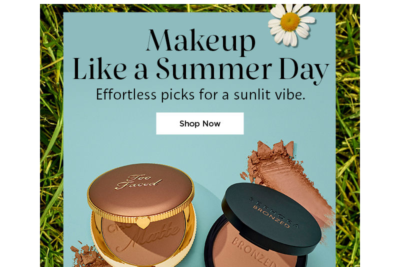Even though transactional emails see 8x more opens and clicks than any other type of email — and can generate 6x more revenue — it’s shocking to see how many companies fall short. In our unboxing blog series we take a look at the transactional emails of the biggest and most popular retailers. Join us to see what’s working, what’s not, and apply these learnings to your own transactional emails.
A Closer Look at Parachute Home
A few minutes of clicking through the emails and web pages for Parachute Home might make you long for a cozy bed, soft sheets and a comfy pillow while you surf. If so, Founder and CEO Ariel Kaye and her marketing team have done their jobs.
Kaye launched Parachute in 2014 after she stayed at a small Italian hotel and fell in love with the comfortable bedding. She began her retail operation when she was unable to find similar bedding, using organic materials and for a moderate price, once back home in California.
Today, the company has two stores, one in Venice Beach and the other in Portland, Oregon, along with an ecommerce business and a trade program for home-design professionals. The company sells everything for beds: linens, duvets, pillows and feather beds, along with other home textiles, décor and accessories.
The company’s twin themes of personal care and social responsibility are evident in their emails, ads, and on the website. Common images, copy, color palette, and a focus on the product eliminate disconnect between the channels.
The emails themselves, while not following a rigid template, show how well they’re integrated with the company’s strong branding. They have a recognizable inbox presence (sender name and subject line tone) as well as images and content that strongly reflects their brand. Parachute’s messaging is the same across channels, a key ingredient for a company that strives to sell a lifestyle as well as a bedding set.
See the examples below:

The Parachute purchase experience
The website and broadcast email show a strong uniformity of message – similar images, content, color palette and voice. Does this branding stream flow unbroken through Parachute’s transactional messages?
The MailCharts data team purchased a pair of waffle-weave slippers for $29 plus shipping to find out. We’ll examine three key ecommerce emails – the welcome email, the order confirmation and the shipping notice. To view the entire customer journey, sign up for MailCharts.
The welcome email

This message checks all of the boxes for an effective welcome email:
- It’s clearly branded and has a clean, uncluttered, look. This is consistent with their website experience.
- The copy, written as a greeting from the CEO and over her signature, thanks the customer for signing up and explains the company’s mission. The content feels authentic, which sets a good tone from the beginning. Also, notice the personalized greeting.
- It aims to send subscribers back to the website by offering product suggestions. Notice how these suggestions are framed as “My Picks,” maintaining the personal approach.
All that’s missing – and it might be an intentional exclusion – is an invitation to visit the stores in Venice Beach and Portland.
The order confirmation

The message layout and design continues the clean, uncluttered, look we saw earlier.
This email also checks all the boxes:
- The order recap includes an image of the product, quantity and price as well as the billing and shipping addresses.
- The order number and contacts for customer service are easy to find – this is essential for a useful order confirmation.
- This email was designed to leave no room for doubt, even reminding the customer to look for another email with tracking information.
One small nitpick: it would have been great to see the payment information details (credit card type and the last four digits). If you’ve ever saved your credit cards in your browser or used a tool like 1Password, you know how easy it is to pay with the wrong card.
As with the welcome email, the order confirmation is sent over CEO Ariel Kaye’s signature, which reinforces her identification with her brand. We love the closing line, too: “Now, get ready to start and end your day feeling your very best.” That’s the company ethos in a nutshell.
We’ve sometimes suggested adding recommended products to the order confirmation email. Given the personal tone of this email, it’s actually great that Parachute decided to do without these recommendations. The email feels more on-brand as-is.
The shipping notification

This email’s design remains very consistent with the previous two emails we saw. The tracking button is highly visible and easy to click, and we appreciated the proviso that the link might not be ready to click for 24 hours. (That never stops us from clicking it, though, just in case.)
While we appreciate that Parachute’s brand voice avoids the hard sell, this email did miss the opportunity to engage further. Why not invite customers to come back to the site while they wait for their packages to arrive?
You can do this in a non-pushy way: Give us some products to check out that might go with what we ordered. Let us know what’s on sale. Send us to the blog to get some inspiration that could spur another sale. Invite us to show off our purchases on your Instagram. Don’t let us get distracted by other retailers while we wait!
This email has relatively few message elements, so adding cross-sell and upsell content would not distract from the shipping notice or make it overly promotional.
The Parachute Home Unboxing Experience
We’ve teamed up with our friends at Lumi to bring you this great unboxing experience. Check it out:
Final Comments
It’s rare to find this kind of tight messaging across marketing channels. Nicely done, Parachute!
Even amongst larger companies with bigger marketing teams, transactional emails often don’t match their broadcast cousins in branding, design, tone and voice. Often, another department (IT, ecommerce, fulfillment) owns them and overlooks — or ignores — the brand and engagement opportunities they represent.
Here, Parachute’s team has taken pains to align even the most prosaic transactional message – the shipping notification – with the rest of the pack, providing a unified message from the very start of the journey and giving each message a clear purpose and value for the customer.
The deeply personal tone of the welcome and order confirmation emails and the consistently clean, uncluttered look of the transactional emails make them a pleasure to receive and are a hallmark of a carefully conceived email-marketing strategy.


